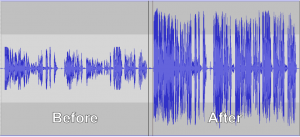One-Touch Voice Post Processing
 I own a basic USB microphone that captures reasonably good voice recordings, and on my computer, I record using an audio editor called Audacity.
I own a basic USB microphone that captures reasonably good voice recordings, and on my computer, I record using an audio editor called Audacity.
Then, using my audio editor, I post process the voice using my special recipe, comprising five audio effects, in a specific sequence. That transforms the recording from good…to awesome!
However, if I’m making a lot of voice recordings, post processing each one five times can become a bit arduous and time consuming.
Some audio software products come with the ability to save a series of audio functions in a particular sequence. In Audacity this is called a Chain. In Adobe Audition, it’s called a Script. These allow me to, for instance, save my voice processing recipe as a single, one touch pre-set. This not only includes what audio functions are used, but what settings within each audio function (see the EQ setting below). Then, I simply open a dialogue box, click on my chosen pre-set, and the recording is transformed before my eyes.
A chain or script is also very useful for single functions as well.
For example, if my recording has popping or overly loud breath sounds, I will want to reduce the volume of those sections. I can highlight the loud noise, open my Amplify effect and slide the gain to -6dB. But after the fortieth time, I’m starting to get tired of that. Solution? I can set up a -6dB setting in my Amplify effect, and save that as a chain or pre-set. Then, one click…done.
If you have a large number of audio files that you wish to process, it is possible to use your Chain or Script pre-sets to batch process them all, with one command. For example, adding my voice recipe to twenty station ID recordings.
This works for me, and saves me a lot of effort. Check it out for yourself.
Happy broadcasting
PS: My voice recipe is:
• Start with a noise reduction to remove any constant noise.
• Normalise to -1
• Equalise (cut all frequencies under 100Hz, reduce all frequencies between 300Hz and 1KHz by 2dB, and tiny boosts at 6KHz and 12KHz to add a bit of sparkle)
• Compress
• Soft Limit to -4db
• Normalise to -1
: Blogs